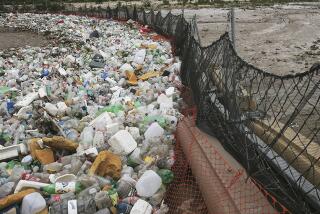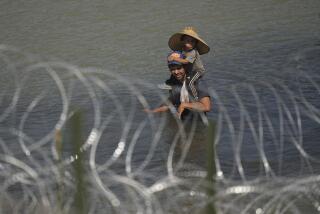Bilbray Pushes Dirt Instead of Paper
Saying his constituents were tired of living near a stench-ridden breeding ground for mosquitoes, San Diego County Supervisor Brian Bilbray on Tuesday defended his decision to step behind the wheel of a bulldozer and redirect a portion of the sewage-infested Tijuana River.
Bilbray said he knew he might be in violation of federal law when he bulldozed a three-cubic-yard area of an “illegal” levee, thus diverting raw sewage from a willow grove and into Lake Tijuana, otherwise known as Shelton’s Pond.
“I got behind the bulldozer and did it,” said Bilbray, who, as mayor of Imperial Beach in 1980, got behind a bulldozer to create a dam that stopped sewage from contaminating a portion of that city.
Although he said he acted on his own Monday, Bilbray claimed to have the backing of the county health department, the Sierra Club and the Environmental Health Coalition.
“If somebody was going to get in trouble, I wanted it to be me rather than somebody else,” he said.
The river and the land near it fall under the control of the federal International Boundary and Water Commission. Robert Ybarra, a spokesman for the IBWC, said Tuesday from El Paso, Tex., that his agency will “look into” the bulldozing.
“All we can say now is that it was quite a surprise to us,” Ybarra said. “We had no prior knowledge of it. We did not give Mr. Bilbray permission to do that. We’re checking into it, and that’s about all we know for now.”
Bilbray said that, by rechanneling the river to what may have been its original course, he believes the bulldozing reduced the flow of sewage into the willow grove by as much as 30%.
“It was creating quite a problem for the Nestor area,” said Bilbray, whose District 1 extends from the Mexican border to Mission Bay and eastward from the ocean to the Sweetwater and Otay Lakes area. “We eliminated a lot of the breeding area by shortcutting everything into the lake.
“When the sewage gets into the grove, it’s not only impossible to get in and spray, it also drowns the willow habitat, which acts as a nesting ground for an endangered species, the least Bell’s vireo,” a small songbird.
“What we’ve been doing for two years is working on an environmental study of the valley--how we can keep sewage from becoming a health hazard and destroying the habitat,” Bilbray said. “We can’t treat the area with larvacides, because the mosquito fish we use can’t survive in sewage, but, of course, mosquitoes can. By cutting out just three cubic yards, we were able to turn (the sewage) back in and solve a lot of the problem.”
Bilbray said he had asked the federal government for a permit to do the bulldozing, but it’s “been tied up in red tape” for more than three months. He said that “time was of the essence” since the bulldozing needed to be done “before the rainy season to have an effect.”
“If there had been adequate environmental enforcement in the valley, none of this would have been necessary,” he said. “I decided, let’s get the job done and talk about it later. There’s not a judge and jury in the country who would find that my intent was to create a health hazard or endanger wildlife. Clearly, it was just the opposite.”
More to Read
Sign up for Essential California
The most important California stories and recommendations in your inbox every morning.
You may occasionally receive promotional content from the Los Angeles Times.










